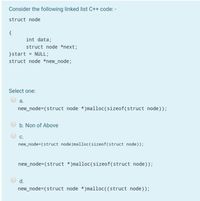
Database System Concepts
7th Edition
ISBN: 9780078022159
Author: Abraham Silberschatz Professor, Henry F. Korth, S. Sudarshan
Publisher: McGraw-Hill Education
expand_more
expand_more
format_list_bulleted
Question

Transcribed Image Text:Consider the following linked list C++ code: -
struct node
{
int data;
struct node *next;
}start = NULL;
struct node *new_node;
Select one:
а.
new_node=(struct node *)malloc(sizeof(struct node));
b. Non of Above
C.
new_node=(struct node)malloc(sizeof(struct node));
new_node=(struct *)malloc(sizeof(struct node));
d.
new_node=(struct node *)malloc((struct node));
Expert Solution
This question has been solved!
Explore an expertly crafted, step-by-step solution for a thorough understanding of key concepts.
Step by stepSolved in 2 steps

Knowledge Booster
Learn more about
Need a deep-dive on the concept behind this application? Look no further. Learn more about this topic, computer-science and related others by exploring similar questions and additional content below.Similar questions
- In c++, how do I display the last node in a linked list?arrow_forwardstruct insert_at_back_of_sll { // Function takes a constant Book as a parameter, inserts that book at the // back of a singly linked list, and returns nothing. void operator()(const Book& book) { /// TO-DO (3) /// // Write the lines of code to insert "book" at the back of "my_sll". Since // the SLL has no size() function and no tail pointer, you must walk the // list looking for the last node. // // HINT: Do not attempt to insert after "my_sll.end()". // ///// END-T0-DO (3) ||||// } std::forward_list& my_sll; };arrow_forwardTrue/False Select true or false for the statements below. Explain your answers if you like to receive partial credit. 3) Which of the following is true about the insertBeforeCurrent function for a CircularLinked List (CLL) like you did in programming exercise 1?a. If the CLL is empty, you need to create the new node, set it to current, andhave its next pointer refer to itselfb. The worst case performance of the function is O(n)c. If you insert a new element with the same data value as the current node, theperformance improves to O(log n)arrow_forward
- Create a user-defined function called duplicates. This function will check to see if a singly linked list contains nodes with the same data stored. If any duplicates are found, return the value 1. Otherwise return 0. You may use the following typedef structure. typedef struct node_s{ int data; struct node_s * nextptr; }node_t;arrow_forwardIn C++.arrow_forwardT/F: All Linked Lists must have head node.arrow_forward
- Assume a linked list contains following integers: 7, 2, 9, 5, 8, 3, 15 and the pointer head is pointing to the first node of the list. What will be the value of variable a after the following statements are executed: Node<int> *curNode=head; Node<int> *aNode; int s; while(curNode!=NULL){ { aNode=curNode; curNode=curNode->getNext(); } s=aNode->getItem(); A. 15 B. 3 C. 7 D. 2arrow_forwardJava/Data Structures: The Java Class Library implementation of the interface list return null when an index is out of range. True or Falsearrow_forwardProject 2: Singly-Linked List The purpose of this assignment is to assess your ability to: ▪Implement sequential search algorithms for linked list structures ▪Implement sequential abstract data types using linked data ▪Analyze and compare algorithms for efficiency using Big-O notation For this assignment, you will implement a singly-linked node class. Use your singly-linked node to implement a singly-linked list class that maintains its elements in ascending order. The SinglyLinkedList class is defined by the following data: ▪A node pointer to the front and the tail of the list Implement the following methods in your class: ▪A default constructor list<T> myList ▪A copy constructor list<T> myList(aList) ▪Access to first elementmyList.front() ▪Access to last elementmyList.back() ▪Insert value myList.insert(val) ▪Remove value at frontmyList.pop_front() ▪Remove value at tailmyList.pop_back() ▪Determine if emptymyList.empty() ▪Return # of elementsmyList.size() ▪Reverse order of…arrow_forward
- Having trouble with creating the InsertAtEnd function in the ItemNode.h file below. " // TODO: Define InsertAtEnd() function that inserts a node // to the end of the linked list" Given main(), define an InsertAtEnd() member function in the ItemNode class that adds an element to the end of a linked list. DO NOT print the dummy head node. Ex. if the input is: 4 Kale Lettuce Carrots Peanuts ------------------------------------------------------- main.cpp -------------------------------------------------------- #include "ItemNode.h" int main() { ItemNode *headNode; // Create intNode objects ItemNode *currNode; ItemNode *lastNode; string item; int i; int input; // Front of nodes list headNode = new ItemNode(); lastNode = headNode; cin >> input; for (i = 0; i < input; i++) { cin >> item;…arrow_forwardDSarrow_forwardWith Head node or not? statement is: if(p->rlink != first) p = p->rlink; O a. It is a Doubly linked list without Head node. O b. It is a Doubly linked list with Head node.arrow_forward
arrow_back_ios
arrow_forward_ios
Recommended textbooks for you
 Database System ConceptsComputer ScienceISBN:9780078022159Author:Abraham Silberschatz Professor, Henry F. Korth, S. SudarshanPublisher:McGraw-Hill Education
Database System ConceptsComputer ScienceISBN:9780078022159Author:Abraham Silberschatz Professor, Henry F. Korth, S. SudarshanPublisher:McGraw-Hill Education Starting Out with Python (4th Edition)Computer ScienceISBN:9780134444321Author:Tony GaddisPublisher:PEARSON
Starting Out with Python (4th Edition)Computer ScienceISBN:9780134444321Author:Tony GaddisPublisher:PEARSON Digital Fundamentals (11th Edition)Computer ScienceISBN:9780132737968Author:Thomas L. FloydPublisher:PEARSON
Digital Fundamentals (11th Edition)Computer ScienceISBN:9780132737968Author:Thomas L. FloydPublisher:PEARSON C How to Program (8th Edition)Computer ScienceISBN:9780133976892Author:Paul J. Deitel, Harvey DeitelPublisher:PEARSON
C How to Program (8th Edition)Computer ScienceISBN:9780133976892Author:Paul J. Deitel, Harvey DeitelPublisher:PEARSON Database Systems: Design, Implementation, & Manag...Computer ScienceISBN:9781337627900Author:Carlos Coronel, Steven MorrisPublisher:Cengage Learning
Database Systems: Design, Implementation, & Manag...Computer ScienceISBN:9781337627900Author:Carlos Coronel, Steven MorrisPublisher:Cengage Learning Programmable Logic ControllersComputer ScienceISBN:9780073373843Author:Frank D. PetruzellaPublisher:McGraw-Hill Education
Programmable Logic ControllersComputer ScienceISBN:9780073373843Author:Frank D. PetruzellaPublisher:McGraw-Hill Education

Database System Concepts
Computer Science
ISBN:9780078022159
Author:Abraham Silberschatz Professor, Henry F. Korth, S. Sudarshan
Publisher:McGraw-Hill Education

Starting Out with Python (4th Edition)
Computer Science
ISBN:9780134444321
Author:Tony Gaddis
Publisher:PEARSON

Digital Fundamentals (11th Edition)
Computer Science
ISBN:9780132737968
Author:Thomas L. Floyd
Publisher:PEARSON

C How to Program (8th Edition)
Computer Science
ISBN:9780133976892
Author:Paul J. Deitel, Harvey Deitel
Publisher:PEARSON

Database Systems: Design, Implementation, & Manag...
Computer Science
ISBN:9781337627900
Author:Carlos Coronel, Steven Morris
Publisher:Cengage Learning

Programmable Logic Controllers
Computer Science
ISBN:9780073373843
Author:Frank D. Petruzella
Publisher:McGraw-Hill Education